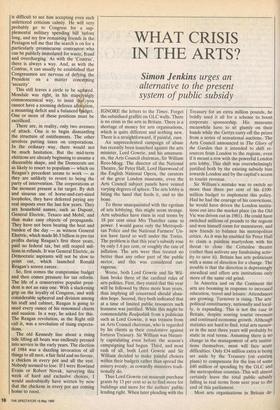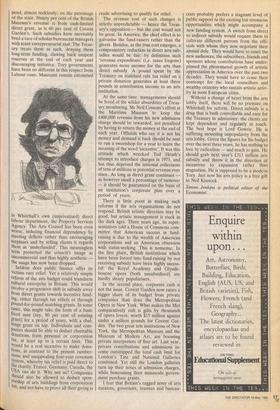WHAT CRISIS IN THE ARTS?
Simon Jenkins urges an
alternative to the present system of public subsidy
IGNORE the letters to the Times. Forget the subsidised graffiti on GLC walls. There is no crisis in the arts in Britain. There is a shortage of money for arts organisations, which is quite different and nothing new.
There is a straightforward, if painful, cure.
An unprecedented campaign of abuse has recently been launched against the arts minister, Lord Gowrie, and his amanuen- sis, the Arts Council chairman, Sir William Rees-Mogg. The director of the National Theatre, Sir Peter Hall, Lord Harewood of the English National Opera, the curators of the great London museums, even the Arts Council subject panels have vented varying degrees of spleen. The arts lobby is biting the hand that feeds it, and to the bone.
To those unacquainted with the egotism of arts lobbying, this might seem strange. Arts subsidies have risen in real terms by 18 per cent since Mrs Thatcher came to power. I would guess only the Metropoli- tan Police and the National Farmers' Un- ion have fared so well under the Tories. The problem is that this year's subsidy rose by only 5.8 per cent, or roughly the rate of inflation. The arts were thus treated no better than any other part of the public sector, and this was considered out- rageous.
Worse, both Lord Gowrie and Sir Wil- liam broke three of the cardinal rules of arts politics. First, they stated that this year will be followed by three more lean years, thus implying all concerned should aban- don hope. Second, they both indicated that at a time of limited public resources such leanness was justified. While this might be commendable Realpolitik from a politician such as Lord Gowrie, it wAs treason from an Arts Council chairman, who is regarded by his clients as their condottiere against fortress Treasury. Sir William was blatant- ly capitulating even before the season's campaigning had begun. Third, and most rash of all, both Lord Gowrie and Sir William decided to make painful choices within their budgets rather than spread the misery evenly, as cowardly ministers tradi- tionally do.
Thus Lord Gowrie cut museum purchase grants by 13 per cent so as to find more for buildings and more for the authors' public lending right. When later pleading with the Treasury for an extra million pounds, he boldly used it all for a scheme to boost corporate sponsorship. His museums meanwhile have to sit glumly on their hands while the Gettys carry off the prizes from a series of sensational auctions. The Arts Council announced in The Glory of the Garden that it intended to shift re- sources from London to the regions, even if it meant a row with the powerful London arts lobby. This shift was overwhelmingly justified both by the existing subsidy bias towards London and by the capital's access to tourist revenue.
Sir William's mistake was to switch no more than three per cent of his £100- million budget to implement this policy. Had he had the courage of his convictions, he would have driven the London institu- tions out into the market place (as the Old Vic was driven out in 1981). He could have switched millions of pounds to the regions and won himself room for manoeuvre, and new friends to balance his metropolitan critics. As it was he enabled Sir Peter Hall to claim a painless martyrdom with his threat to close the Cottesloe theatre (rather than activate any fundraising activ- ity to save it). Britain has arts politicians with a sense of direction for a change. The trouble is that the direction is depressingly unradical and offers arts institutions only more of the same old grind.
In America and on the Continent the arts are booming in response to increased education, travel and leisure. Attendances are growing. Turnover is rising. The arts' political constituency, nationally and local- ly, is expanding. This is not the case in Britain, despite soaring tourist revenues and continued economic growth. Although statistics are hard to find, total arts turnov- er in the next three years will probably be static in real terms. Assuming there is no change in the management of arts institu- tions themselves, most will face acute difficulties. Only £34 million extra is being set aside by the Treasury (on existing plans) to compensate for the loss of some £40 million of spending by the GLC and the metropolitan counties. This will almost certainly leave the total public subsidy falling in real terms from next year to the end of this parliament. Most arts organisations in Britain de- pend, almost recklessly, on, the patronage of the state. Ninety per cent of the British Museum's revenue is from cash-limited direct grant, as is 60 per cent of Covent Garden's. Such subsidies have inevitably bred a race of scholar/bureaucrat managers with scant entrepreneurial zeal. The Treas- ury treats them as such, denying them long-term funding, clawing back unspent reserves at the end of each year and discouraging initiative. Tory governments have been no different in this respect from Labour ones. Museums remain entombed in Whitehall's own (unprivatised) direct labour department, the Property Services Agency. The Arts Council has been even Worse, inducing financial dependency by meeting deficits rather than encouraging surpluses and by telling clients it regards them as 'underfunded'. This meaningless term protected the council's image as uncommercial and thus highly aesthetic the usage has now been dropped. Seldom does public finance offer its victims easy relief. Yet a relatively simple reform of the arts budget could transform cultural enterprise in Britain. This would involve a progressive shift in subsidy away from direct grants towards incentive fund- ing, either through tax reliefs or through Pound-for-pound matching grants. In some Cases, this might take the form of a basic fixed sum (say, 80 per cent of existing grant) for a period of years, with a chal- lenge grant on top. Individuals and com- panies should be able to deduct charitable donations from personal or corporation tax, at least up to a certain limit. This Would be a real incentive to make dona- tions, in contrast to the present cumber- some and unappealing four-year covenant sYstem, whereby tax relief is paid direct to the charity. France, Germany, Canada, the USA can do it. Why not us? Companies should also be allowed to deduct spon- sorship of arts buildings from corporation tax, and not have to prove all their giving is crude advertising to qualify for relief.
The revenue cost of such changes is strictly unpredictable — hence the Treas- ury's opposition — but the cost would not be great. In America, the chief effect is to galvanise the fund-raisers rather than the givers. Besides, as the true cost emerges, a compensatory reduction in direct arts sub- sidies would be fair: by definition such `revenue expenditure' (i.e. taxes forgone) generates more income for the arts than direct subsidy. A pound spent by the Treasury on standard rate tax relief on a private donation generates at least three pounds in contribution income to an arts institution.
At the same time, managements should be freed of the wilder absurdities of Treas- ury monitoring. Mr Neil Cossons's effort at the Maritime Museum to keep the £400,000 revenue from his new admission charge should be rewarded, not penalised by having to return the money at the end of each year. Officials who say it is not his money and demand it back should be sent to run a sweetshop for a year to learn the meaning of the word 'incentive'. It was this attitude which wrecked Ted Heath's attempt to introduce charges in 1973, and has thus deprived the national collections of tens of millions in potential revenue ever since. As long as direct grant continues as however small a percentage of turnover — it should be guaranteed on the basis of an institution's corporate plan over a period of years.
There is little point in making such reforms if the arts organisations do not respond. British artistic direction may be good, but artistic management is stuck in the dark ages. Three years ago, its repre- sentatives told a House of Commons com- mittee that American success in fund- raising is due to the wealth of American corporations and an American obsession with status-seeking. This is nonsense. In the first place, British institutions which have been forced into fund-raising by not receiving subsidy have been highly sucess- ful: the Royal Academy and Glynde- bourne opera (both unsubsidised) are hardly sleazy popularisers.
In the second place, corporate cash is not the issue. Covent Garden now raises a bigger share of its budget from private companies than does the Metropolitan Opera in New York. What makes the Met comparatively rich is gifts by thousands of opera lovers: worth $15 million against under a million pounds for Covent Gar- den. The two great arts institutions of New York, the Metropolitan Museum and the Museum of Modern Art, are booming private interpreters of fine art. Last year, private contributions and admissions in- come outstripped the total cash limit for London's Tate and National Galleries combined. Yet still the London galleries turn up their noses at admission charges, while bemoaning their minuscule govern- ment purchase grants.
I fear that Britain's ragged army of arts curators, governors, trustees and bureau-
crats probably prefers a stagnant level of public support to the exciting but strenuous opportunities which might accompany a new funding system. A switch from direct to indirect subsidy would require them to cultivate different patrons from the offi- cials with whom they now negotiate their annual dole. They would have to court the new audiences, the subscribers, friends and sponsors whose contributions have under- pinned the phenomenal growth of artistic appreciation in America over the past two decades. They would have to cease their contempt for the local councillors and wealthy citizenry who sustain artistic activ- ity in most European cities. • Without a change of heart from the arts lobby itself, there will be no pressure on Whitehall for reform. Direct subsidy is a drug that is both controllable and easy for the Treasury to administer: the clients are kept dependent and regularly in touch. The best hope is Lord Gowrie. He is suffering mounting unpopularity from the arts lobby. Given the figures for his budget over the next three years, he has nothing to lose by radicalism — and much to gain. He should grab next year's £313 million arts subsidy and throw it in the direction of incentives to expansion rather than stagnation. He is supposed to be a modern Tory. Just now his arts policy is a free gift to Neil Kinnock.
Simon Jenkins is political editor of the Economist.















































 Previous page
Previous page